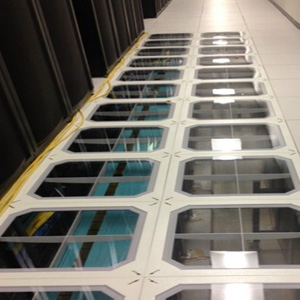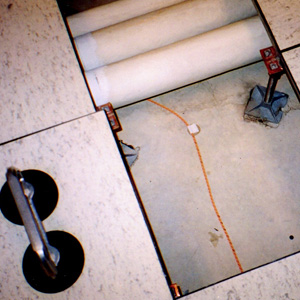Do You Know What Is Going On Under Your Raised Floor? You Should!
Every year we sell thousands of raised floor panels to facilities worldwide. Once a flooring system is installed, many facility managers don’t fully realize that they’ve created a space – the underfloor plenum – the space between the floor and the raised floor tile – that they cannot see. How do you keep tabs on this space? Through their years of experience, the specialists at RLE Technologies have learned that out of sight truly is out of mind… until it isn’t! Join Cam Rogers and Jennifer Beliveau as they share their best tips and tricks for monitoring and maintaining the underfloor plenum space, and help you avoid those “isn’t” situations.
Jennifer Beliveau recommends using Clearview raised floor tiles to create a window into your plenum:
 Sub-floor plenums in many data centers have historically retained and may still contain a “spaghetti” maze of cables. These obstructions can have a major impact on the performance of under floor air distribution. To improve cooling efficiency, many data centers clear out their plenums by managing cables and then take a closer look at their the sub floor conditions. RLE’s Clearview raised floor panels not only provide a quick glimpse of the general condition of the plenum space but they also allow you to see displays and readouts – like those found on temperature and air pressure measurement equipment – in the plenum. Customers often leverage these environmental monitoring tools to identify cooling issues before they become dangerous to critical equipment. Clearview panels also allow for the constant and uncomplicated oversight of gauges and valves used to determine water temperature and pressure. They are also useful in ensuring there are no leaks in pipe connections as more data centers are using chilled water supply and return pipes to cool cabinets, in-row chillers, and heat exchangers.
Sub-floor plenums in many data centers have historically retained and may still contain a “spaghetti” maze of cables. These obstructions can have a major impact on the performance of under floor air distribution. To improve cooling efficiency, many data centers clear out their plenums by managing cables and then take a closer look at their the sub floor conditions. RLE’s Clearview raised floor panels not only provide a quick glimpse of the general condition of the plenum space but they also allow you to see displays and readouts – like those found on temperature and air pressure measurement equipment – in the plenum. Customers often leverage these environmental monitoring tools to identify cooling issues before they become dangerous to critical equipment. Clearview panels also allow for the constant and uncomplicated oversight of gauges and valves used to determine water temperature and pressure. They are also useful in ensuring there are no leaks in pipe connections as more data centers are using chilled water supply and return pipes to cool cabinets, in-row chillers, and heat exchangers.
And speaking of underfloor water supplies, Cam Rogers has just the right solution to ensure a water leak is pinpointed quickly and efficiently, preventing system downtime and damage to critical equipment:
 Many data centers use the valuable space under raised floors to direct cold air to the areas of the facility that most need it. Unfortunately, raised floors also provide a hiding place for one of the bigger threats to these critical spaces – conductive fluids. It is not unusual to use the plenum space to house the chiller supply and return lines that provide coolant to computer room air conditioners and air handlers. Unfortunately, when these lines generate a leak in the areas of a facility that are not visible the small initial issue may not be identified until it becomes a much larger leak that wreaks havoc on the facility. Historically, spot detectors have been used to identify fluid leaks but in reality they are only ideal in small contained areas, such as drip pans. We recommend using SeaHawk leak detection sensing cables in this plenum space. They provide a reliable way to both detect that there is a leak and also pinpoint the location of the leak. This ensures leaks are resolved quickly and efficiently. Our customers use SeaHawk sensing cable to encapsulate areas of concern in a plenum space, to trace lengths of piping for quick leak detection, and to identify sources of the leaks in areas that may not be visible. SeaHawk sensing cables report leaks to our controllers, which ensure the right people know about issues before they become serious problems.
Many data centers use the valuable space under raised floors to direct cold air to the areas of the facility that most need it. Unfortunately, raised floors also provide a hiding place for one of the bigger threats to these critical spaces – conductive fluids. It is not unusual to use the plenum space to house the chiller supply and return lines that provide coolant to computer room air conditioners and air handlers. Unfortunately, when these lines generate a leak in the areas of a facility that are not visible the small initial issue may not be identified until it becomes a much larger leak that wreaks havoc on the facility. Historically, spot detectors have been used to identify fluid leaks but in reality they are only ideal in small contained areas, such as drip pans. We recommend using SeaHawk leak detection sensing cables in this plenum space. They provide a reliable way to both detect that there is a leak and also pinpoint the location of the leak. This ensures leaks are resolved quickly and efficiently. Our customers use SeaHawk sensing cable to encapsulate areas of concern in a plenum space, to trace lengths of piping for quick leak detection, and to identify sources of the leaks in areas that may not be visible. SeaHawk sensing cables report leaks to our controllers, which ensure the right people know about issues before they become serious problems.
Leave a Reply
